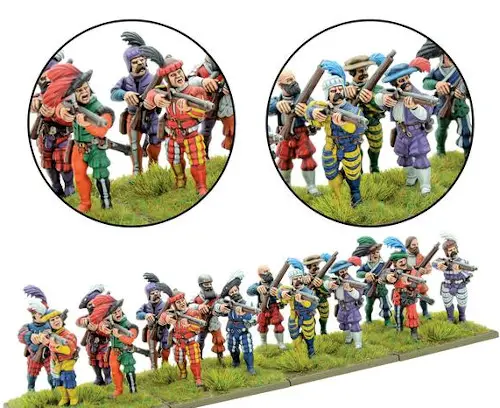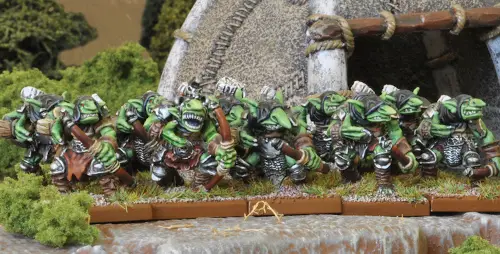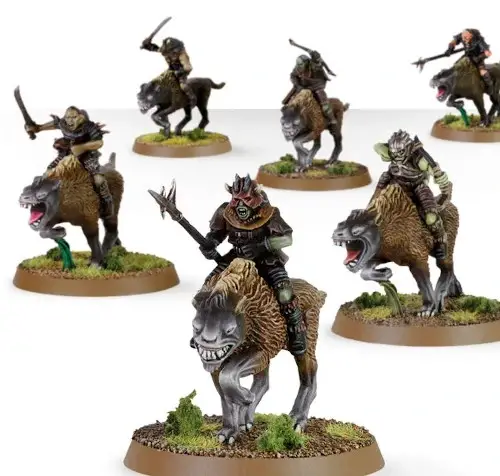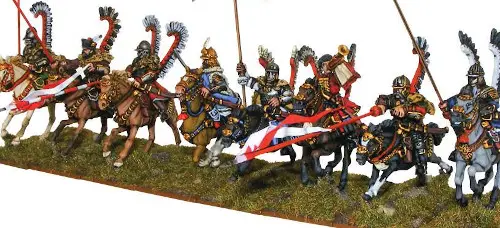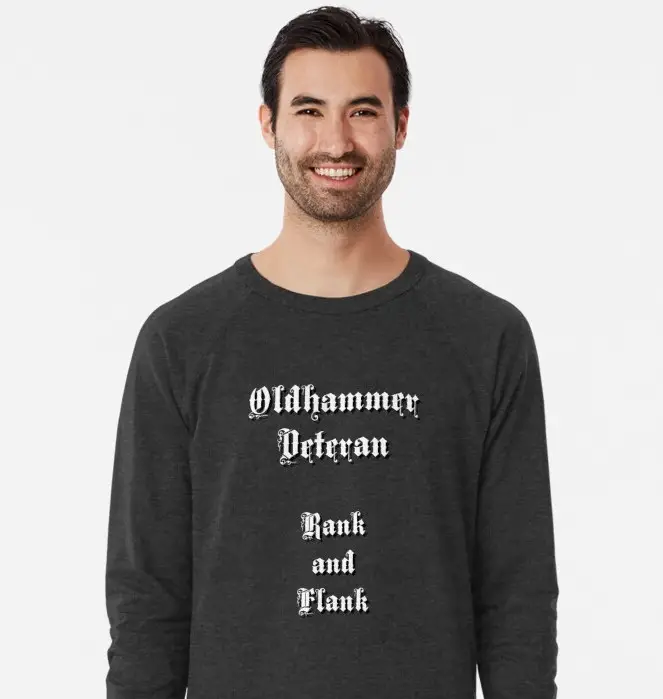Alternative Miniatures for Warhammer Fantasy, A Guide
What follows is a guide to the tricky issue of sourcing miniatures for Warhammer Fantasy Battles in the Age of Sigmar. We will look at the whys and howtos of sourcing alternative miniatures.
Much of what is written here will also apply to The Old World. If you are interested in The Old World why check my article on starting an Old World army before its release.
Let us start by looking at the various motives for sourcing alternatives miniatures for Warhammer Fantasy Battles (or indeed The Old World).
Reasons for Seeking Alternatives
There are four different reasons for looking at alternatives to GW’s miniatures for those playing Warhammer Fantasy Battles. It is important to be clear on what those reasons are to get the most out of those alternatives. Also to deal with the issues that can arise.

Availability
Sometimes a particular unit or character is simply no longer stocked or produced by Games Workshop. This is becoming increasingly an issue as the Age of Sigmar drags on.
Catastrophically for some players entire factions have disappeared from the shelves, notably Tomb Kings and Bretonnians.
This is not an entirely new problem rising out of the Age of Sigmar Apocalypse either. Kislev was another faction, albeit not a fully developed one, that had its entire line of models discontinued from production and distribution. That was well before the Age of Sigmar hit us.
Aside from entire factions disappearing many factions have seen some kits or models disappear from sale. Some of them were integral to the faction. Most of Empire kits live on in the Age of Sigmar but the crucial Empire Knights kit does not.
This is a powerful reason for the player of Warhammer Fantasy Battles to look at alternative model kits from other producers. If one wants Empire Knights but GW does not supply them, then what else can one do but look beyond GW’s official offering?
Of course Warhammer Fantasy Battles is a game with a long life, three decades at least, and a fairly vast following. It has had a colossal turnover by tabletop wargaming standards. For this reason availability is a relative term because whatever is not available new is almost certainly still floating around out there in the second hand markets, such as Craigslist and Ebay.
That availability is there but it has its own costs and problems.
Cost
Even where new kits are still available from GW or resellers they tend to be relatively expensive. For some of us that is an issue. Warhammer Fantasy Battles is a game that tends run to a high model count so any savings on models can make a big difference.
The cost factor only gets worse with discontinued models sourced from the second hand market. That enduring demand coupled with diminishing supply only makes for still even higher prices.
See here what official GW Empire Knights will go for on Ebay.
The expense of models depends a lot on the materials used. As a rule metal and resin miniatures tend to be substantially more expensive than plastic. GW produces in sufficient volumes that they have been able to produce a lot of their lines in plastic. Whereas many smaller miniature companies do not. GW may place a premium mark-up on their wares but as it happens they are not always the most expensive option. Having it in plastic will do that.
That said, comparing like for like, we see that GW plastics can easily be twice as expensive as other plastics. Compare with the plastics of companies like Perry, Warlord Games, Fireforge Games and Mantic.
For a fairly close comparison let us compare: Games Workshop’s State Troops Handgunners / Crossbowman Kit with Warlord Games’ Landsknecht Missile Troops kits. Both sets are full plastic, 28mm infantry with near identical weapon options. They can both be assembled as either handgunners or crossbowmen and include plastic bases.
Empire State Troops Handgunners and Crossbowmen Kit by Games Workshop
This is a kit with which many Warhammer veterans will be familiar. At the time of writing Element Games stocks this for £17.50. It makes 10 men, armed either with handguns or crossbows. See here for the current price.
Landsknecht Missile Troops by Warlord Games
In contrast this is a kit with which most Warhammer players, even veterans, will not be familiar. It comes from a line of historical miniatures for the early age of gunpowder produced by Warlord Games.
Stylistically, and in terms of weapon options, the kit is a close fit for Warhammer Fantasy’s Empire faction as an alternative to State Troop Handgunners. Warhammer’s Empire of course was very closely inspired by the Holy Roman Empire of history for which these landsknechts fought.
At the time of writing Element Games stocks this at a sale price of £16.20. This is on sale down from its regular price of £18. Click here for the current price.
If we take it at its regular price, then it looks like it is a tiny bit more expensive than GW’s Empire Handgunners, £17.50 vs £18. The trick however is this kit can make 30 men not 10! This means that really, like for like, GW is per model three times more expensive than comparable plastics.
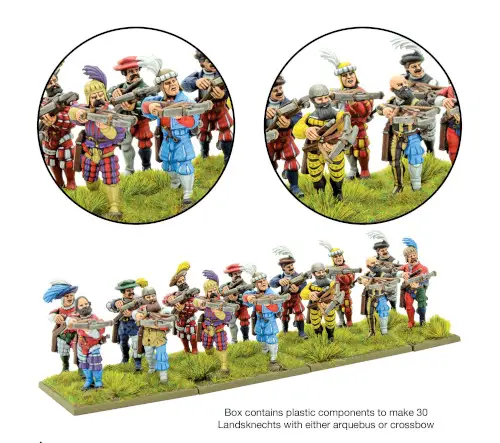
Kit Comparison
It is fair to say that even these two kits are not completely comparable. This is because the former kit has some particular options and aesthetics specific to Warhammer, which the latter kit does not. For one thing the former kit has a Hochland Longrifle. For another thing it has some rather goofy aiming devices. The latter kit has neither of course. These are things the Warhammer player may miss.
Interestingly the historical landsknechts are rather more flamboyantly dressed than their fantasy equivalents. Possibly this is a rare example of when history is more fun than fantasy.
It must also be cautioned that historical kits like this tend to follow rather natural proportions while GW’s Warhammer products tend to have very warped proportions with oversized extremities. More on that later.
This price comparison does go to show the huge potential savings to had in alternatives to Games Workshop’s miniatures. This is particularly true with historical miniatures. A three to one price advantage is not small…
Variety
It so happens that Warhammer armies can be very large, or large for 28mm scale, involving many hundreds of models. This is especially true for army lists crafted for the 8th edition. Warhammer Fantasy 8th edition tends to favour large blocks of infantry.
Even with the benefit of multi-part plastic kits to make those large blocks some repeats can become obvious. This begs for variety to break up the homogeneity.
This is where third party kits, especially ones designed to fit with Games Workshop’s rather weird proportions, can work wonders.
For a random example Mantic’s Kings of War lines have more than a few miniatures, a lot of it in plastic, which could supplement GW’s fantasy troops without looking very out of place. I could see these Goblin Spitters mixed in with GW’s goblin archers for some extra variety. What do you think?
Of course kitbashing for variety is an option here too.
Aesthetics
Aesthetically one just might like another companies’ models better than Games Workshop’s models. That can happen particularly for those who prefer true scale over heroic. The encephalitic heads and swollen hands of GW’s heroic scale are not for everyone.
GW largely contrived their Warhammer version of orcs and goblins for comedy relief. For this reason they are styled in a rather silly way. Compare with LOTR orcs. Personally, your friendly guide Solar Cross, enjoys that take on orcs and goblins but some others may not. These hypothetical bods may prefer their orcs as serious baddies more like how Tolkien conceived of them.
Interestingly GW also makes orcs both serious and true-scale for their Lord of the Rings franchise. Thus in this instance one could change aesthetics without leaving GW’s reservation. GW here is an alternative to itself.
Could you see yourself using LOTR warg riding orcs as Warhammer goblin wolf riders? The comment box awaits you.
While I prefer silly orcs and goblins over serious, I have to admit these models are far better looking than GW’s Warhammer wolf riders.
See what else is good looking in LOTR’s range here.
If you like true scale over heroic scale then you may be interested my True Scale Warhammer Fantasy Battles Project.
Opportunities for Seeking Alternatives for Warhammer
Now that we have covered the why, let us look at the where. Where can we source our alternative Warhammer miniatures?
Historical Miniature Lines
For the human factions such as The Empire, Bretonnia, Kislev or indeed Tilean mercenaries from the Dogs of War the sourcing opportunities are vast. Virtually every line of fantasy miniatures have something human that might work as an alternative. There are also the equally vast historical lines from which to draw. Put together that is a vast array of options.
In fact because GW fairly shamelessly raided history for its human aesthetics, so historical lines can make far aesthetically closer proxies than even other fantasy offerings.
We have already seen how closely Holy Roman Empire landsknechts can stand in for Empire gunners. It should be no surprise that models made for the War of the Roses or the Crusades work very well for the Arthurian legend chic of the Bretonnians. Likewise could you not see Polish Winged Hussars as alternative Kislevians? Granted, bear riders will require some extensive kitbashing…
Historical Miniatures for Dogs of War and Regiments of Renown
A veteran ebayer, such as myself, can tell you that the long discontinued lines of Dogs of War can go for crazy money on ebay.
Taste the crazy. If you happen to have any Dogs of War festering in your pile of shame, you now know what you must do…
Yet more than a few of these Dogs of War and Regiments of Renown are straight up clones of historical Italian pikemen or crossbowmen. They could easily be proxied by such for chump change. In particular I am thinking of Braganza’s Besiegers, Bronzino’s Galloper Guns, Leopold’s Leopard Company, Marksman of Miragliano, Ricco’s Republican Guard, The Alcatani Fellowship, Vespero’s Vendetta and Voland’s Venators. All could be proxied with historical minis with the barest minimum of kitbashing.
For another example, Pirazzo’s Lost Legion is an obvious clone of the legendary historical Spanish adventurer Pizarro and his conquistadors. Pirazzo’s Lost Legion could easily be proxied by pikes and crossbowmen in Spanish style Morion helmets. Again for a fraction of the price of lost relics of GW.
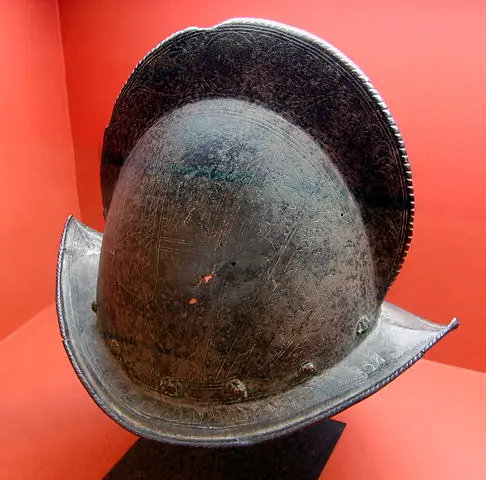
Historical Miniatures for the Warhammer Armies Project
In the lore of the Warhammer world many other human factions are hinted at, if not fleshed out: Araby, Norsca, Hind, Cathay and Nippon. It should be no surprise to any that all of these factions have their aesthetic derived from real historical equivalents, namely: medieval Arabs, Norse / Vikings, India, China and Japan.
What may surprise some is that thanks to the Warhammer Armies Project there are now actual Army Books for them! And thanks to historical miniature manufacturers, since forever, there are even models for them too!
Third Party Fantasy
Whatever alternatives that historical miniatures may offer Empire and Bretonnia players they offer nothing to the many non-human factions of the Warhammer world. Tomb Kings must continue to cry bitter, sandy tears for the crushing prices they must pay for gungy, sticky and mis-glued resold GW plastics on ebay. See here why the poor Tomb Kings must cry tears of sand…
Or not! GW is not the only model making company with a fantasy offering, yes really! Indeed there are more than a few producers out there who have consciously contrived an offering overtly meant to be usable in GW games such as Warhammer Fantasy Battles.
Perhaps in an alternative reality where GW was a tiny company vainly trying to push their encephalitic models, messy contradictory rules and derivative lore on a suitably unimpressed clientele, then these orbiter companies would not surrender so completely to the awesome gravity well of GW’s black Sun. They would make their own fandom, instead of riding on GW’s own.
Companies Following GW – The Orbiters
But as it is, when one has bills to pay and the supermassive black Sun of GW has captured all your potential customers even while bleeding their wallets dry with troll worthy mark-ups, then it takes a feisty turn of mind indeed to not surrender to the pull and just make your own derivative of a derivative models. These I call the Orbiters.
The Orbiters are invaluable for Warhammer players looking for models that work interchangeably with GW’s minis. Same scale, same weird “heroic” proportions, often WYSIWYG compatible in terms of armaments troop types and even sharing a close aesthetic.
The disadvantage with the orbiters is that usually they are very small companies. Orbiting is an attractive option for small companies as they lack the facilities and funding to create their own brand-able aesthetic. It does mean however that small companies will also not have the funds for the expensive steel moulds needed for cheap plastics. They may have beautiful and compatible sculpts but they will tend to be in metal or resin and likely no cheaper than a GW offering.
You can tell an Orbiter by the fact that they only sell models or model parts and no game system of their own. They do not need it when they can ride on GW’s game.
Examples of Orbiters
Examples of Orbiters would be: MOM miniaturas, Gamezone Miniatures, NorbaMiniatures. The largest of them would be Avatars of War. Oddly enough a lot of them seem to be Spanish. Helpfully Element Games do stock Avatars of War so they are easily accessible in the UK and other English speaking countries.
See here for how much of the Avatars of War range is currently available at Element Games.
Companies Blazing their Own Trail – The Blazers
There are others who are determined to break free of the precipitous pull of GW’s aesthetic gravity well. They have forged their own narrative by cultivating their own possibly less derivative aesthetic. I call these companies Blazers. Yet, coincidently of course, even these forgers of their own narratives have none-the-less produced some models which are absolutely usable as alternatives for GW’s minis.
These more ambitious companies may even have something, or a lot of things, in lovely, lovely multi-part plastic. However these companies are often not trying very hard for compatibility with GW. Their scale may be a bit off, or truescale, the WYSIWYG options will be off and the aesthetics distinctly un-Warhammer. Finding something suitable as an alternative for Warhammer can be a bit of a slog, depending on how fussy you are.
These companies will generally have their own game system with attendant lore. GW has shown that selling a game system is a great way to sell models in volume even with a premium.
Examples of Blazers
Examples of Blazers would be: Mantic (Kings of War), Privateer Press (Hordes).
A Bit of Both
I would class Fireforge Games as being a bit of an Orbiter as well as a Blazer. They are a Blazer in that they have their own historical game Deus Vult to support their excellent line of historical miniatures. Indeed they have a game for their new line of fantasy models too, Forgotten World.
However they are also an Orbiter in the sense that their later minis for Forgotten World were consciously designed to be completely compatible with GW’s heroic scale and usable as alternative Bretonnians. Lucky for us these Forgotten World minis are in plastic.
Suffice to say that both the Orbiters and the Blazers stand to gain from GW’s self-sacrificing abandonment of the Warhammer Old World.
Issues with Alternatives to GW and their Solutions
Naturally there are issues that can arise with using non-GW miniatures and we touched on a few already. Let us look a little closer at the issues that can arise.
One issue is rather moot now that Warhammer Fantasy is no longer supported by GW. GW stores generously allow customers free use of in-store gaming tables. The operative word being “customers”, try taking a force composed, even in part, by minis sourced from another manufacturer and you not be considered a customer and shown the door.
However now that the Age of Sigmar is upon us they likely would not let you play Warhammer Fantasy Battles there either, even with a pure GW sourced force.
Scale
There is a wide inconsistency in how manufacturer’s label their scales. 28mm can be to the eye level of one and to the top of the head in another.
This is not necessarily a huge issue to my mind because humans and other creatures will vary is size from one specimen to another. Think Tyrion and the Mountain from Game of Thrones. If your soldiers varied a bit in size that might make for a more natural look than the size uniformity that may go with staying with only one manufacturer.
That said size variations can make for incompatibilities for simple kitbashing operations like head and arm swaps which you may need to do to solve some WYSIWYG or aesthetic requirements.
Solution
You could try not caring. If your game pieces are game pieces rather than works of art then what matters most is that they communicate what they are and what they do in the game. If they look nicely scaled next to each other after that then it is a bonus.
Or not. Some of us are into tabletop wargames like Warhammer Fantasy Battles to fulfill an aesthetic need as well as a gamer need. If it were not so why even use painted miniatures at all? We could go full poorhammer and just use paper and card counters instead.
The solution here then can only be research and avoid assuming 28mm from one maker will match 28mm from another. Future instalments in this series of articles may help with that, as I intend to make and publish size comparisons for all suitable miniatures for each Warhammer faction.
Proportions
Far more troublesome than some wonkiness in scale is in the closely related matter of proportion.
Most lines of miniatures are proportioned naturally. Heads, hands and feet are sized relative to each other as they would be for a real creature. This is called true scale but this refers to proportions rather than scale as such.
GW and Orbiter miniatures, excepting the models made for Lord of the Rings and the Hobbit, are proportioned with unnaturally broad bodies and swollen extremities, such as hands, heads and feet. This is what is really meant by heroic scale. It is less a matter of indicating the height of the model as indicating the proportions.
The issue here is that while heroic scale minis often looks fine alongside other heroic scale minis, they look awful when placed alongside true scale miniatures.
Simple kit bash procedures like head and weapon swaps between true scale and heroic scale miniatures will not work either.
This image found on warosu.org/tg/ illustrates this beautifully.
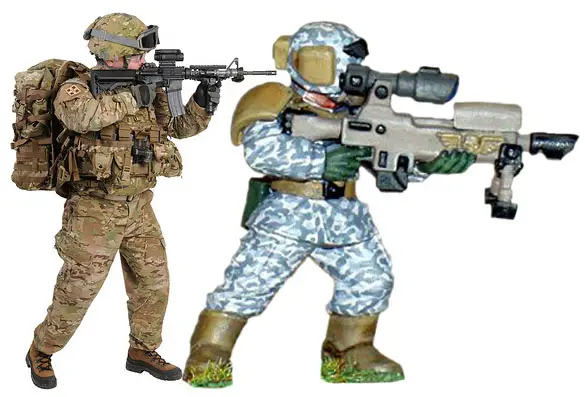
On the right.. a potato.
You may also be interested in my True Scale Warhammer Fantasy Battles project.
Solution
Again you could try not caring. There I said it, you could treat your game pieces as abstractions which communicates a game identity and its state and location. The fact that some have potato heads while others do not is neither here nor there.
Or not. As with scale issues, if aesthetics matters at all then proportions will matter. For nice aesthetics, you can only really have one or the other in one army, mixing proportions is far more unsightly than mixing slightly different scales. So you should choose one or the other out of true and heroic scale and stick with it for your whole army. That is if aesthetics matter.
If some GW Warhammer minis are already the basis of your army then that will rather settle the issue. Unless you want to sell them off and start again from scratch.
Having decided on which you will go with be careful to evaluate any new minis you will add to your collection for which scale they are using. Unlike with height variations, proportions are readily apparent from model photos when you know what to look for.
Notes for Non-Human Warhammer Factions
While it is strongly true that mixing true and heroic scale looks bad for human factions, it may be that the differences between true scale and heroic scale are a lot less noticeable in non-human fantasy races.
By virtue of the fact our human eyes are rather keener at distinguishing human forms than non-human ones so then inconsistent proportions in non-humans may be less noticeable. That which is not noticed does not exist.
Another thing is, who is to say what is the natural range of proportions for entirely fictional creatures like dragons and orcs?
Notes for Human Warhammer Factions
It should be said that while fantasy miniatures tend to be split between true scale and heroic, all historical ranges that I have ever seen are solidly in true scale. Given that there such huge savings to be had using historical minis instead of GW, or even other fantasy models, it may be that a switch to true scale may be worth the trouble of selling off any heroic scale minis you have already.
Also while true scale would open up the huge variety of very affordable historical minis it would not restrict you only to them because very many fantasy human minis are in true scale too. Minis made for Frostgrave for one example.
Kit Bash Tricks
While heroic scale is profoundly warped compared with true scale, this is most severe at the extremities and least so with the torso. This means that heroic and true scale torsos are potentially interchangeable (no guarantees!) even if the arms, weapons and heads are not.
Thus in a true scale army you might be able to use true scale arms and heads on heroic torsos for some conversions. Conversely you might be able to use true scale torsos in a heroic army. Maybe.
WYSIWYG
What-You-See-Is-What-You-Get, for those that do not know, is the modelling philosophy that dictates that a model should look like what it does, is or has in the game. A model of a man with a bow in chainmail should not be used to represent a game entity which is an unarmoured zombie with a club.
Casual players may not care so much for this and be happy to play “counts as” but serious players and indeed tournament organisers generally do care about WYSIWYG and may be really quite strict about it.
It has to be said even official GW miniatures do not always match that well with the game rules written for them. Fixing that is a major motivation for some kitbashing. It will be an even trickier challenge to conform to WYSIWYG when using miniatures not designed for Warhammer Fantasy Battles.
It gets especially acute because the final solution to WYSIWYG is an artful kit bash or conversion, which as already noted is complicated by scale and proportion issues which multiply when using models from diverse manufacturers.
Solutions
Research is the key here. Cast a wide net and you stand the best chance of finding minis which fit what you want WYSIWYG. After that get good at kitbashing.
General Buying Strategies
When building a Warhammer Army from alternative minis you will take one of three broad strategies. Which you choose will depend on what you have already, if anything, and what you decide to do about the true scale vs heroic dilemma. Each have their own pros and cons, opportunities and opportunity costs.
Full Alternative
This is composing your army entirely with models from other manufacturers, actively excluding GW models.
The main reason for going full alternative is to make a break from heroic scale to true scale. Full alternative here would not necessarily exclude GW’s LOTR and Hobbit models since they are true scale. If you choose true scale then there will be hardly anything in the official Warhammer offering you can use, perforce you will be having to source your models outside GW’s plantation.
Ease of Going Full Alternative
It is the easiest to do with the more generic fantasy factions such as any of the human, elf, dwarf, undead, orc and goblin factions.
It will be hardest and likely impossible to do with the more unique to GW factions like Chaos Daemons and Skaven. The Lizardmen faction would not be too easy to do this way either. That said Orbiter companies may step in with solutions here too.
The opportunities opened up by switching to true scale are vast though. If you look around you will see that far more minis are true scale than heroic scale, even in the fantasy genre, so the sourcing opportunities and kitbashing opportunities are really huge.
This strategy may preclude having certain very indiosyncratic to Warhammer units though, for which there are no good alternatives. It also effectively cuts off using Orbiter’s minis as they generally use heroic scale to maintain compatibility with GW.
Mix and Match
This is mixing in non-GW minis with official GW Warhammer minis. It naturally mandates sticking with heroic scale unless one is not sensitive to the aesthetic issues that arise mixing true with heroic.
It allows for using Age of Sigmar models, Warhammer models both new and used. But it effectively restricts sourcing alternatives to the smaller set of non-GW models which are also heroically scaled. The majority of those are in resin and metal by small Orbiter companies.
Age of Sigmar models appear to be becoming less herioc scale and more true scale.
Full GW
Technically this is not an alternative at all but it must be mentioned as an option for completeness sake.
There are no real advantages to this over Mix and Match though GW may like you the better for it, if they really care. Ebay will be your friend too because whatever you cannot get from GW or resellers will have to come from the second hand market. Bargains can be had on ebay but overall this will be the most costly way to go about a Warhammer army.

Final Thoughts
There are lots of options if we dig around but also many issues to solve. The biggest issue is dealing with the aesthetic conflict between true scale and heroic scale.
Would you mix heroic scale with true scale?
Share this article to my twitter @SolarCrossGames or my reddit community r/SolarCrossGames and let’s chat about it.

